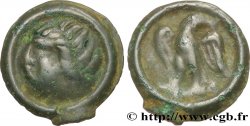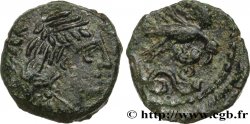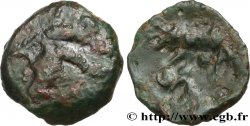bga_215699 - GALLIA - CARNUTES (Area of the Beauce) Huitième de statère d’or à l’aigle, à la mèche tombant sur le front
无库存.
所有在网站上销售的产品 (2013)
价格 : 480.00 €
所有在网站上销售的产品 (2013)
价格 : 480.00 €
种类 Huitième de statère d’or à l’aigle, à la mèche tombant sur le front
日期: Ier siècle avant J.-C.
铸币厂名称/城市 Chartres (28)
材质 gold
直径 9,5 mm
模子方针 6 h.
重量 0,84 g.
稀少度 R3
关于品相的说明
Petite monnaie frappée sur un flan relativement large et irrégulier. Droit et revers confus mais presque complets
家谱
Ce exemplaire provient d’une vente iNumis. Il est publié dans le CN 190 de décembre 2011, page 8, fig. 1 où il est indiqué provenir de Bazoches-les-Hautes (28)
正面
正面的文字 ANÉPIGRAPHE.
正面的说明书 Tête à droite, la chevelure en quatre grosses mèches, une croisette sur la joue.
背面
背面的文字 ANÉPIGRAPHE.
背面的说明书 Aigle à droite, une croix inscrite dans une rouelle perlée dans les serres ; un croissant au-dessus de l’aile.
评论
Sur les quatre huitièmes de statères illustrés dans le Nouvel Atlas, cette monnaie correspond au DT. 2570, avec ce même style de droit et un revers identique.
Ce rare monnayage divisionnaire d’or est bien mieux connu depuis la parution de l’article de N. Manios dans les Cahiers de la SENA n° 190 de décembre 2011 “Les huitièmes de statère à l’aigle carnutes”. Cet exemplaire y figure pour la série “à la tête stylisée marquée d’une croix”, variante “à la mèche tombant sur le front”. Pour ce type précis, seulement trois exemplaires ont été répertoriés ; deux en collection privée et le bga_215699.
Ce rare monnayage divisionnaire d’or est bien mieux connu depuis la parution de l’article de N. Manios dans les Cahiers de la SENA n° 190 de décembre 2011 “Les huitièmes de statère à l’aigle carnutes”. Cet exemplaire y figure pour la série “à la tête stylisée marquée d’une croix”, variante “à la mèche tombant sur le front”. Pour ce type précis, seulement trois exemplaires ont été répertoriés ; deux en collection privée et le bga_215699.








 对产品描述纠错
对产品描述纠错 打印
打印 分享我的选择
分享我的选择 提问
提问 Consign / sell
Consign / sell
 产品介绍
产品介绍










